Search Result
Results for "
EP3
" in MedChemExpress (MCE) Product Catalog:
2
Isotope-Labeled Compounds
| Cat. No. |
Product Name |
Target |
Research Areas |
Chemical Structure |
-
- HY-147226
-
|
|
Prostaglandin Receptor
|
Neurological Disease
Endocrinology
|
|
EP3 antagonist 3 (compound 2) is an orally active, potent and selective EP3 antagonist, with a pKi of 8.3. EP3 antagonist 3 shows excellent pharmacokinetic properties. EP3 antagonist 3 can be used for overactive bladder (OAB) research .
|
-

-
- HY-P5702
-
|
|
Bacterial
Apoptosis
Fungal
|
Infection
|
|
EP3 is an antimicrobial peptide. EP3 has antibacterial and antifungal activities. EP3 inhibits E. gallinarum, P. pyocyanea, A. baumanii, K. terrigena with a MIC value of 12.85 μg/mL. EP3 also shows antitumor activity against cancer cells, and induces cell apoptosis .
|
-
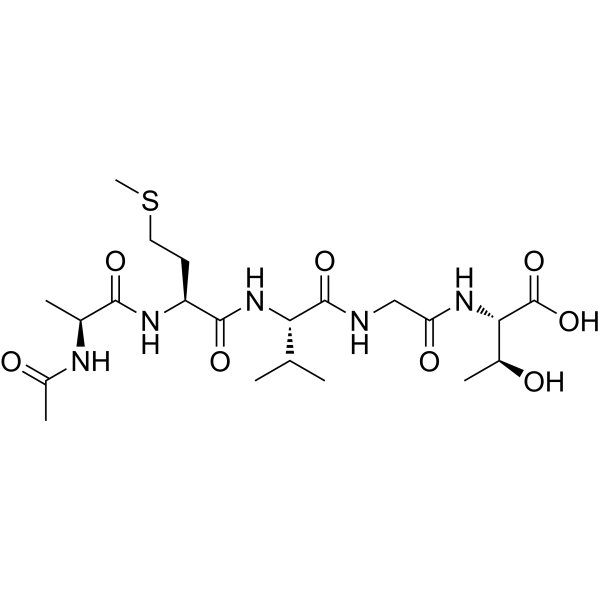
-
- HY-157496
-
|
|
Prostaglandin Receptor
|
Others
|
|
EP3 antagonist 7 (Compound II) is an EP3 receptor antagonist. EP3 antagonist 7 can be used in the study of itching, pain, dysuria or stress disorders .
|
-
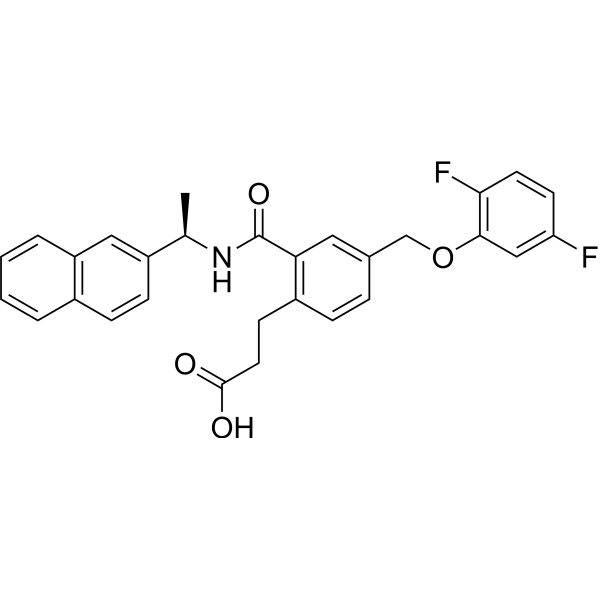
-
- HY-157495
-
|
|
Prostaglandin Receptor
|
Endocrinology
|
|
EP3 antagonist 6 (compound 5) is a potent, orally and selective EP3 receptor antagonist, with an IC50 of 1.9 nM. EP3 antagonist 6 can inhibits PGE2-induced (HY-101952) uterine contraction in pregnant rats .
|
-
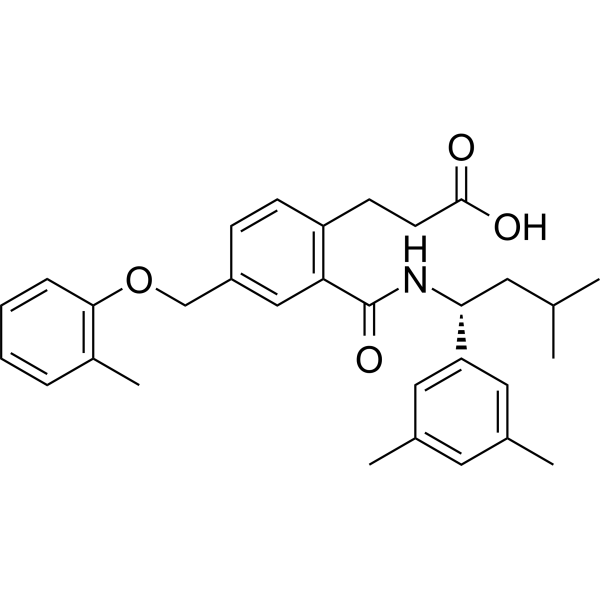
-
- HY-153256
-
|
|
Prostaglandin Receptor
|
Metabolic Disease
|
|
EP3 antagonist 4 (Compound 28) is an EP3 antagonist, with a Ki value of 2 nM for hEP. EP3 antagonist 4 shows low in vivo clearance, high oral AUC, and good bioavailability in the rat full PK studies. EP3 antagonist 4 can be used for research of beta cell dysfunction in diabetes .
|
-

-
- HY-157494
-
-
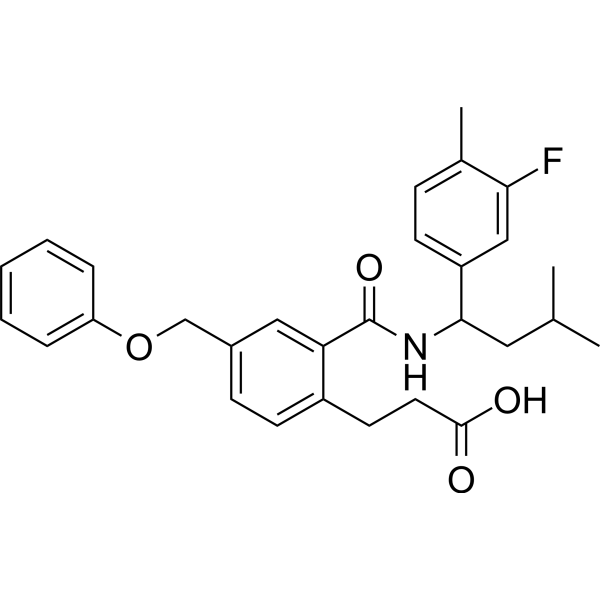
-
- HY-106054
-
|
|
Prostaglandin Receptor
|
Metabolic Disease
Inflammation/Immunology
|
|
Nocloprost, a prostaglandin E2 (PGE2) analog, is an orally active EP1- and EP3-receptor agonist. Nocloprost inhibits evoked [ 3H]ACh release. Nocloprost has gastroprotective and ulcer-healing properties. Nocloprost accelerates the healing of chronic gastric ulcerations and enhances mucosal growth in rats .
|
-
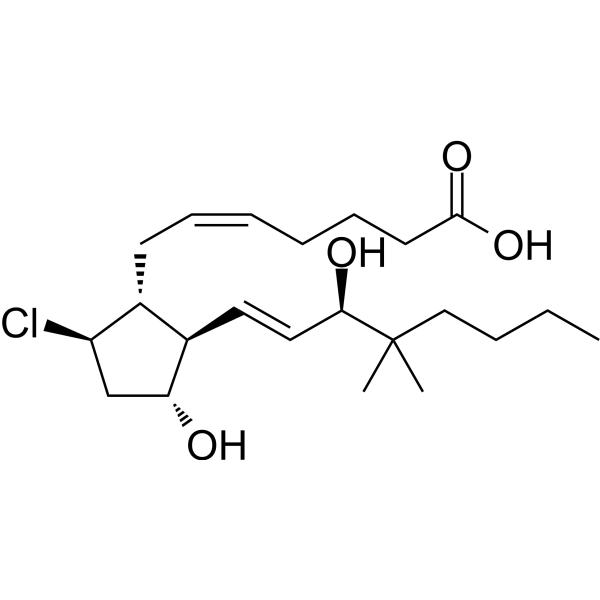
-
- HY-118820
-
-
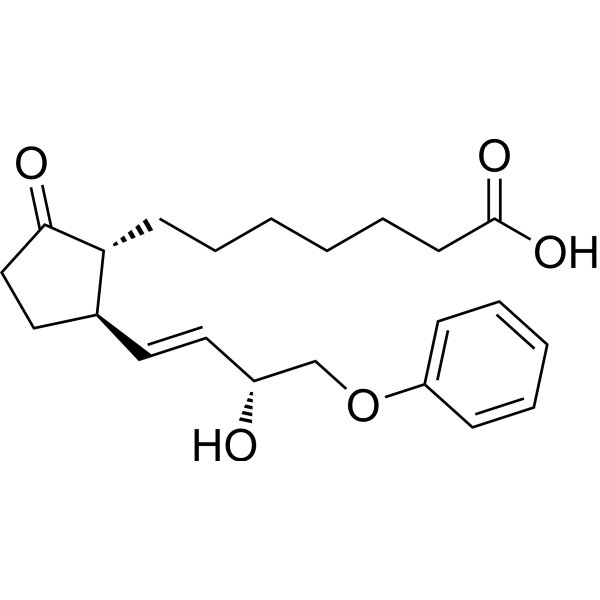
-
- HY-19361
-
|
|
|
|
|
L-826266 is a selective and competitive EP3 receptor antagonist. L-826266 can be used for convulsive disorders research .
|
-
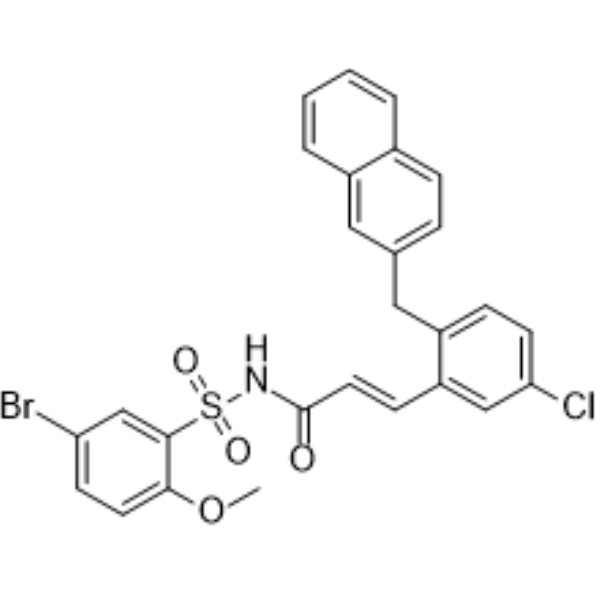
-
- HY-136696
-
|
|
Prostaglandin Receptor
|
Metabolic Disease
|
|
11-Deoxy-16,16-dimethyl-PGE2, a Prostaglandin E2 analog, is a EP2 and EP3 receptors agonist. 11-Deoxy-16,16-dimethyl-PGE2 protects proximal renal tubular epithelial cells from potent nephrotoxicity-induced cell damage by exerting anti-oxidative stress .
|
-
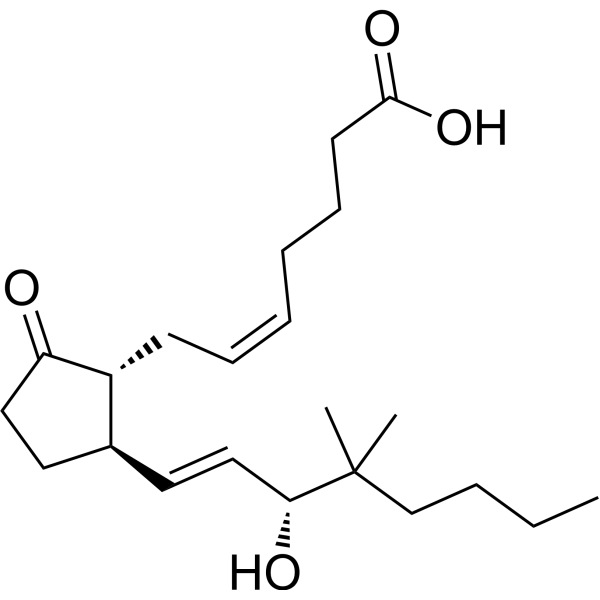
-
- HY-B0131
-
|
Alprostadil; PGE1
|
Prostaglandin Receptor
Endogenous Metabolite
|
Cardiovascular Disease
Endocrinology
Cancer
|
|
Prostaglandin E1 (Alprostadil) is a prostanoid receptor ligand, with Kis of 1.1 nM, 2.1 nM, 10 nM, 33 nM and 36 nM for mouse EP3, EP4, EP2, IP and EP1, respectively. Prostaglandin E1 induces vasodilation and inhibits platelet aggregation. Prostaglandin E1 can be used as a vasodilator for the research of peripheral vascular diseases [3].
|
-
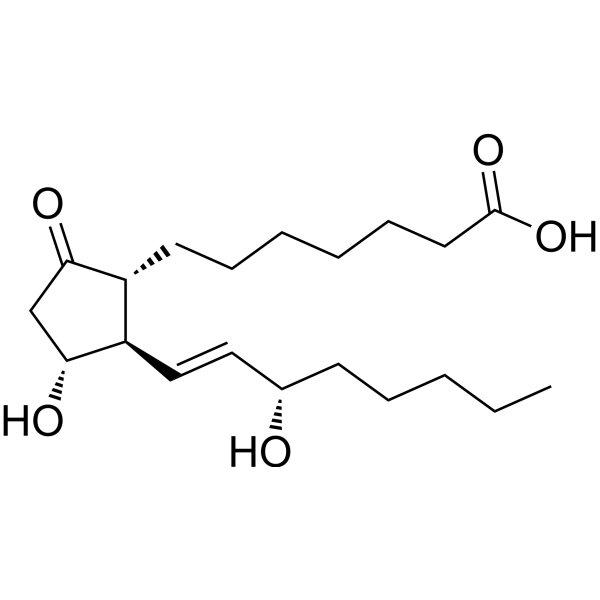
-
- HY-10418
-
-
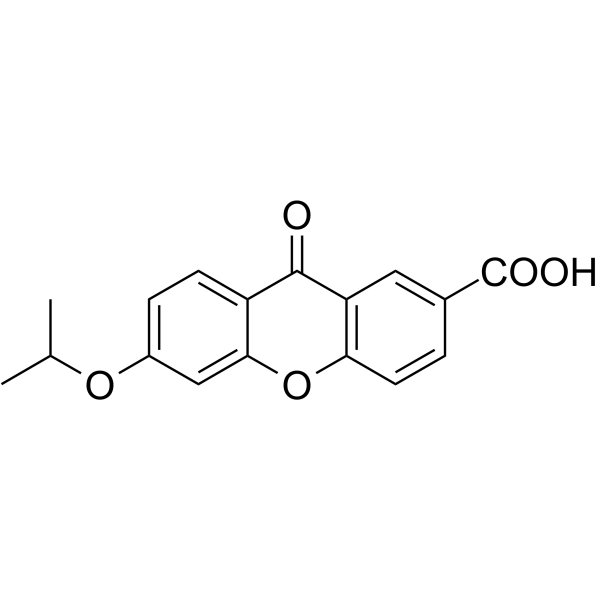
-
- HY-118609
-
-
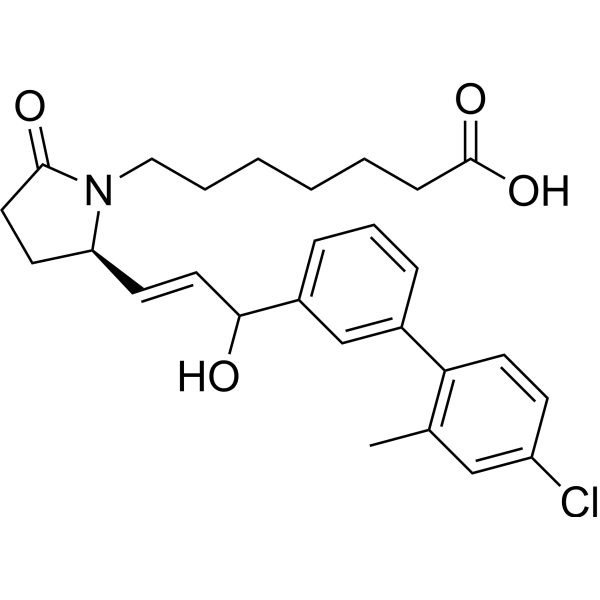
-
- HY-15274
-
|
CM9; GW671021
|
Prostaglandin Receptor
|
Cancer
|
|
L-798106 is potent and highly selective prostanoid EP3 receptor antagonist (Ki=0.3 nM), it also has micromolar activities at the EP4, EP1 and EP2 receptors with Ki values of 916 nM, >5000 nM and >5000 nM, respectively .
|
-
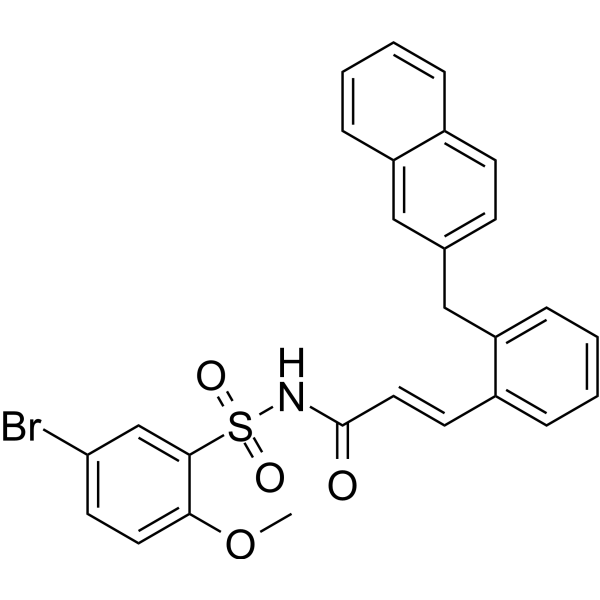
-
- HY-137574
-
|
19(R)-Hydroxy PGE1
|
Prostaglandin Receptor
|
Others
|
|
19(R)-Hydroxy prostaglandin E1 (19(R)-Hydroxy PGE1), the major prostaglandin in primate semen, is an agonist of EP1 and EP3 receptor subtypes and exhibits contractile activity on smooth muscle preparations .
|
-
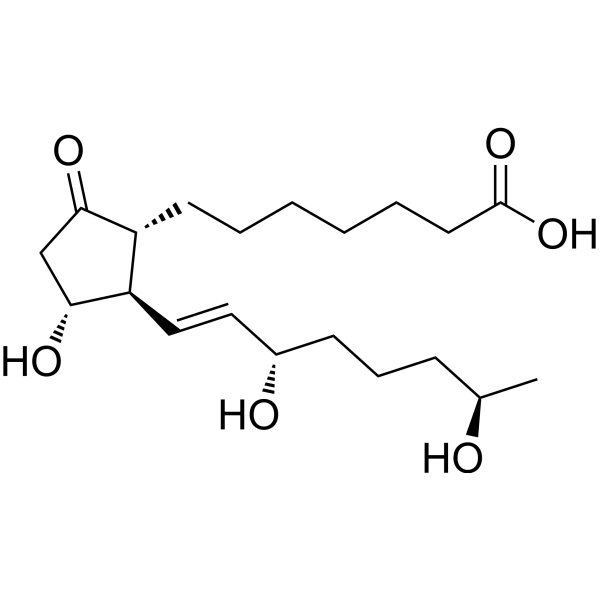
-
- HY-19360
-
|
SHB 286; CP-34089; ZK-57671
|
|
|
|
Sulprostone (SHB 286) is a potent and selective EP3 receptor agonist. Sulprostone (SHB 286) is a prostaglandin E2 (PGE2) analogue and has antiulcer and nonsteroidal abortifacient effects. Sulprostone has potential for the research of pregnancy termination and hemorrhages during delivery [3].
|
-

-
- HY-108563
-
|
|
Prostaglandin Receptor
|
Neurological Disease
|
|
SC 51089 is a selective antagonist of prostaglandin E2 EP1 receptor, with Kis of 1.3, 11.2, 17.5, and 61.1 μM for EP1, TP, EP3, and FP receptors, respectively. SC 51089 exhibits neuroprotective activity [3].
|
-
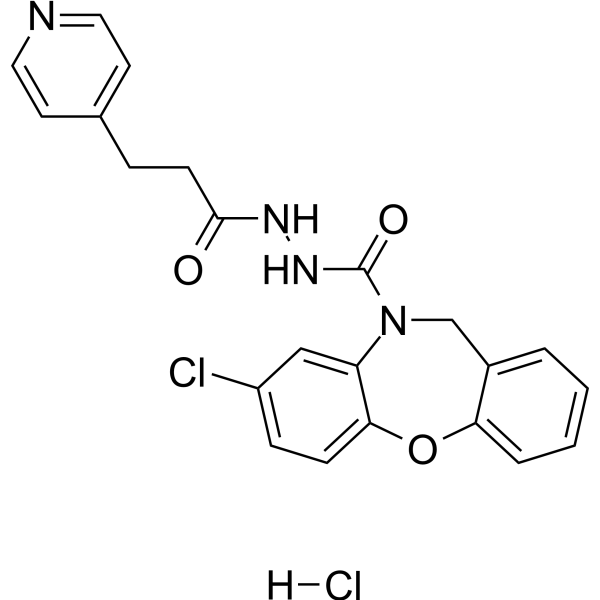
-
- HY-16978
-
-
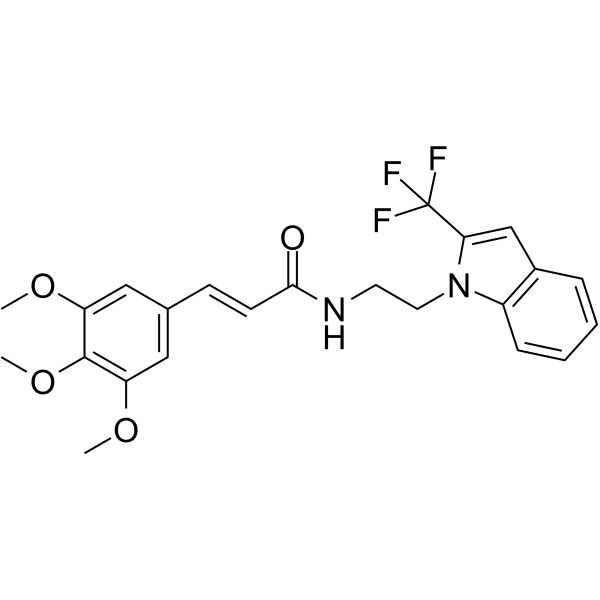
-
- HY-10835
-
DG-041
2 Publications Verification
|
Prostaglandin Receptor
|
Cardiovascular Disease
|
|
DG-041 is a potent, high affinity and selective EP3 receptor antagonist with IC50s of 4.6 nM and 8.1 nM in the binding and FLIPR assay, respectively. DG-041 inhibits PGE2 facilitation of platelet aggregation. DG-041 crosses the blood-brain barrier .
|
-
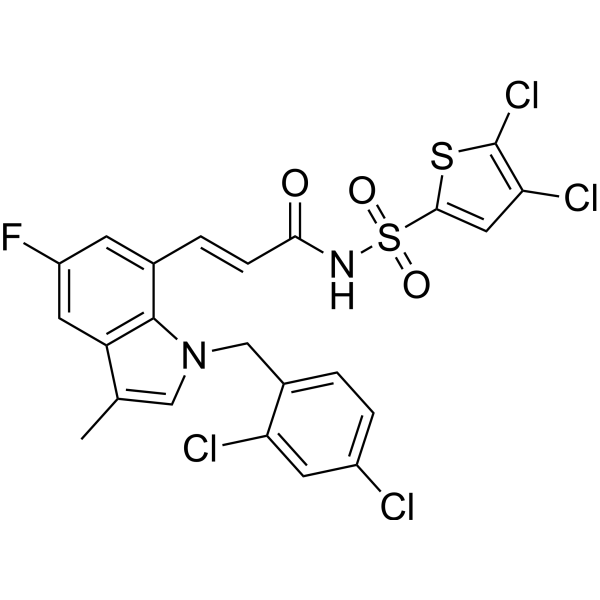
-
- HY-108563A
-
|
|
Prostaglandin Receptor
|
Neurological Disease
|
|
SC 51089 free base is a selective antagonist of prostaglandin E2 EP1 receptor, with Kis of 1.3, 11.2, 17.5, and 61.1 μM for EP1, TP, EP3, and FP receptors, respectively. SC 51089 free base exhibits neuroprotective activity [3].
|
-

-
- HY-10797
-
|
CJ-042794
|
Prostaglandin Receptor
|
Inflammation/Immunology
Endocrinology
|
|
CJ-42794 (CJ-042794) is a potent, orally active, selective prostaglandin E receptor 4 (EP4) antagonist with an IC50 value of 10 nM, which is 200-fold more selective than EP1, EP2 and EP3. CJ-42794 can be used in research of gastric ulcers .
|
-
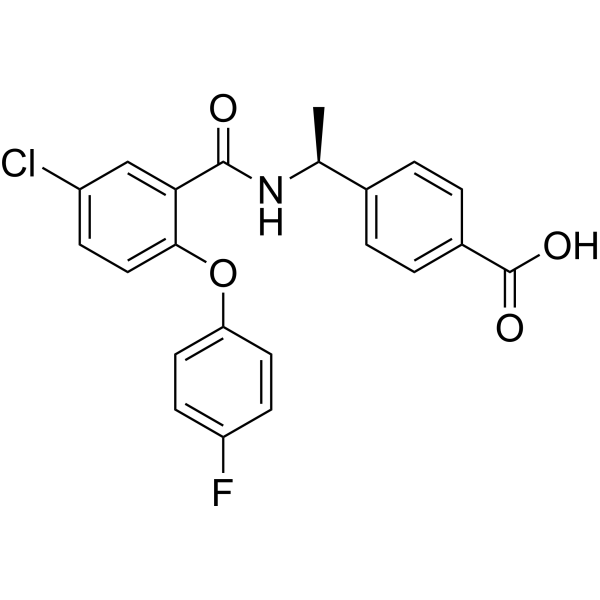
-
- HY-100448A
-
|
|
Prostaglandin Receptor
TGF-beta/Smad
|
Endocrinology
|
|
Butaprost is a selective prostaglandin E receptor (EP2) agonist with an EC50 of 33 nM and a Ki of 2.4 μM for murine EP2 receptor. Butaprost is less activity against murine EP1, EP3 and EP4 receptors. Butaprost attenuates fibrosis by hampering TGF-β/Smad2 signalling [3].
|
-
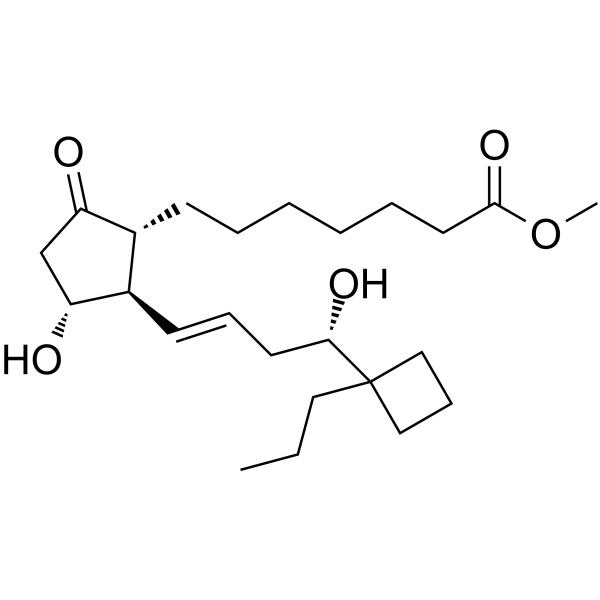
-
- HY-50901
-
ONO-AE3-208
Maximum Cited Publications
9 Publications Verification
AE 3-208
|
Prostaglandin Receptor
|
Endocrinology
Cancer
|
|
ONO-AE3-208 is a selective and orally active EP4 receptor antagonist with a Ki of 1.3 nM. ONO-AE3-208 shows less potently affects EP3, FP, and TP receptors (Ki of 30 nM, 790 nM, and 2400 nM, respectively). ONO-AE3-208 suppresses cell invasion, migration, and metastasis of prostate cancer .
|
-
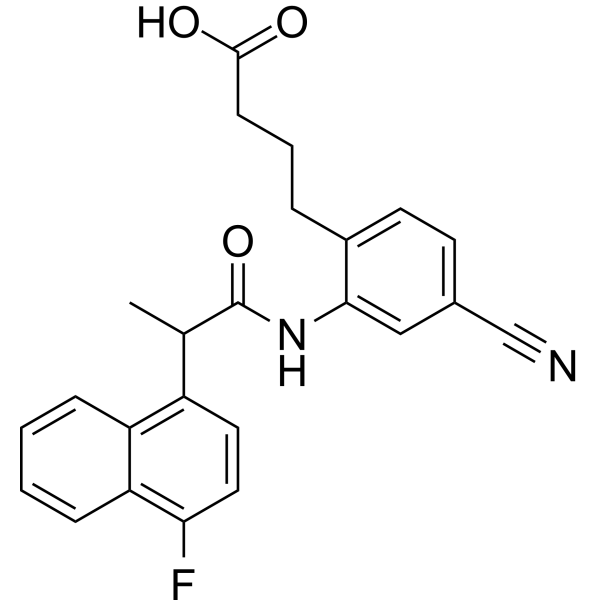
-
- HY-B0131S2
-
-
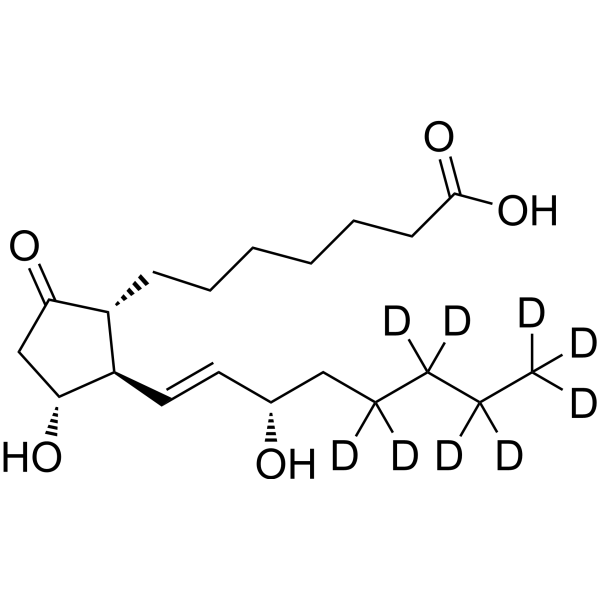
-
- HY-14899
-
|
CP-544326
|
Prostaglandin Receptor
|
Endocrinology
|
|
Taprenepag (CP-544326) is a potent and selective prostaglandin EP(2) agonist with IC50s of 10 and 15 nM for human and rat EP2, respectively. Taprenepag shows selectivity for EP2 over other EP receptors (IC50s>3200 nM for EP1, EP3, and EP4) and a panel of 37 G protein-coupled receptors .
|
-
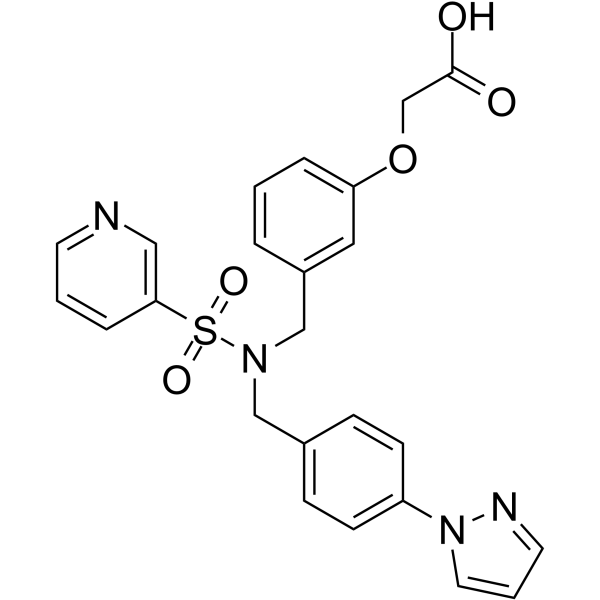
-
- HY-133123
-
|
|
Prostaglandin Receptor
|
Inflammation/Immunology
Cancer
|
|
EP4 receptor antagonist 1 is a highly potent and selective competitive prostanoid EP4 receptor antagonist for cancer immunotherapy. EP4 receptor antagonist 1 inhibits human and mouse EP4 receptor with IC50s of 6.1 nM and 16.2 nM, respectively. IC50s >10 μM for human EP1, EP2,and EP3 receptors .
|
-
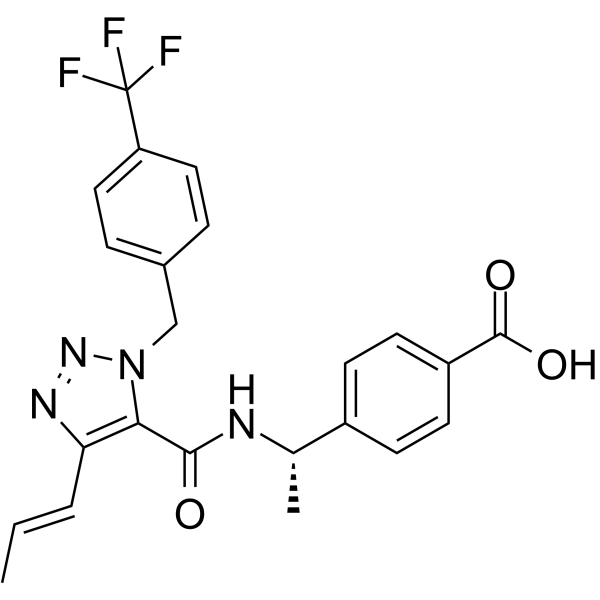
-
- HY-128039
-
|
|
Prostaglandin Receptor
|
Others
|
|
17-Phenyl-ω-trinor-PGE2 is a PGE2 (HY-101952) analog, which is an agonist for EP1 and EP3 receptor. 17-Phenyl-ω-trinor-PGE2 inhibits the PAF-induced aggregation of human platelet-rich plasma (PRP) and Cicaprost (HY-19583) induced Cyclic AMP (HY-B1511) production .
|
-

-
- HY-128686
-
KAG-308
1 Publications Verification
|
Prostaglandin Receptor
|
Inflammation/Immunology
Endocrinology
|
|
KAG-308 is a potent selective and orally active agonist of EP4 receptor (a prostaglandin E2 receptor subtype), suppresses colitis and promotes histological mucosal healing, potently inhibits TNF-α production. KAG-308 shows a Ki and an EC50 of 2.57 nM and 17 nM for human EP4 receptor, respectively, more selective over EP1, EP2, EP3 and IP receptor .
|
-
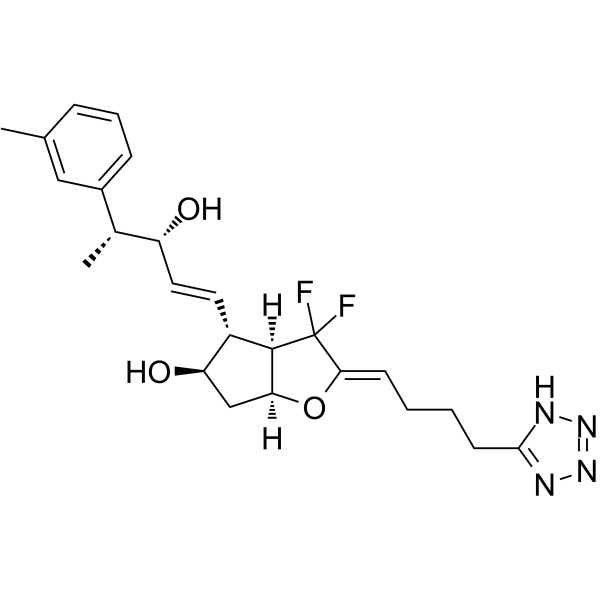
-
- HY-B0601
-
|
AFP-172
|
Prostaglandin Receptor
Drug Metabolite
|
Cardiovascular Disease
Neurological Disease
Endocrinology
|
|
Tafluprost acid (AFP-172), an active metabolic form of Tafluprost, is a selective prostanoid FP receptor agonist. Tafluprost acid shows a high affinity for human prostanoid FP receptor with Ki and EC50 values of 0.4 nM and 0.53 nM, respectively. Tafluprost acid has 126 times weaker binding affinity for prostanoid EP3 receptor (IC50=67 nM) than for the prostanoid FP receptor. Tafluprost acid can be used in the research of glaucoma [3].
|
-

-
- HY-B0131S
-
|
|
Prostaglandin Receptor
Endogenous Metabolite
|
Cardiovascular Disease
Endocrinology
|
|
Prostaglandin E1-d4 is the deuterium labeled Prostaglandin E1. Prostaglandin E1 (Alprostadil) is a prostanoid receptor ligand, with Kis of 1.1 nM, 2.1 nM, 10 nM, 33 nM and 36 nM for mouse EP3, EP4, EP2, IP and EP1, respectively. Prostaglandin E1 induces vasodilation and inhibits platelet aggregation. Prostaglandin E1 can be used as a vasodilator for the research of peripheral vascular diseases[1][2][3].
|
-
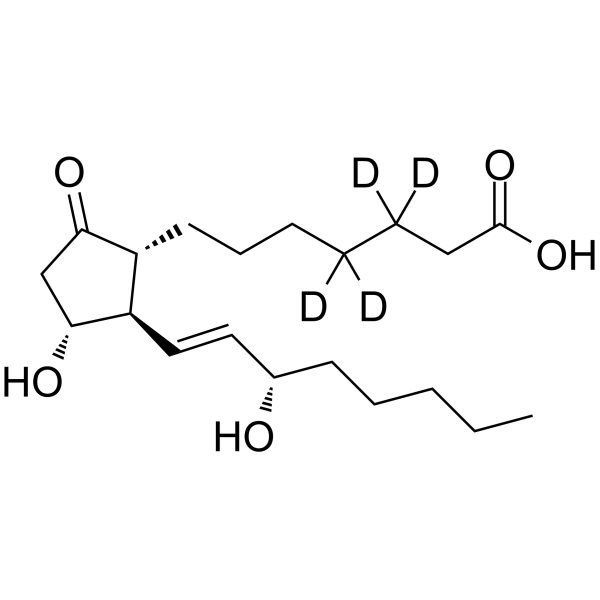
-
- HY-118743
-
|
|
Prostaglandin Receptor
|
Metabolic Disease
|
|
KMN-80, a derivative of PGE1 (HY-B0131), is a selective and potent agonist of EP4 receptor with an IC50 and a Ki of 3 nM and 2.35 nM, respectively. KMN-80 is against EP3 receptor with an IC50 of 1.4 μM and >10 μM for all other prostanoid receptors . KMN-80 is a click chemistry reagent, it contains an Alkyne group and can undergo copper-catalyzed azide-alkyne cycloaddition (CuAAc) with molecules containing Azide groups.
|
-
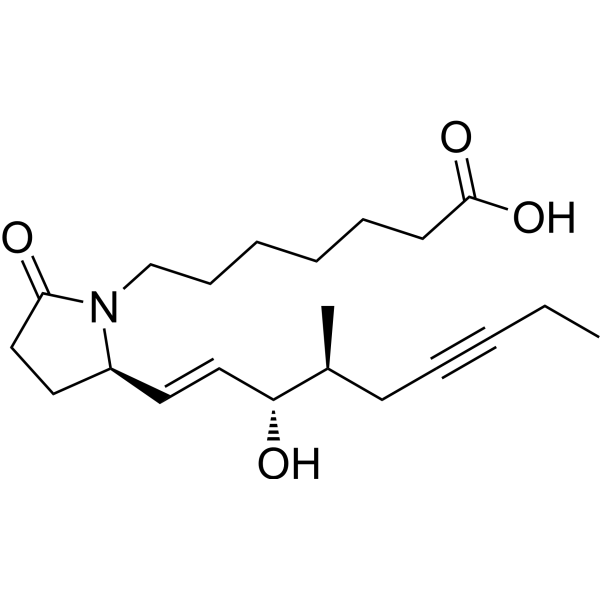
-
- HY-B0131R
-
|
Alprostadil(Standard); PGE1 (Standard)
|
Prostaglandin Receptor
Endogenous Metabolite
|
Cardiovascular Disease
Endocrinology
Cancer
|
|
Prostaglandin E1 (Standard) is the analytical standard of Prostaglandin E1. This product is intended for research and analytical applications. Prostaglandin E1 (Alprostadil) is a prostanoid receptor ligand, with Kis of 1.1 nM, 2.1 nM, 10 nM, 33 nM and 36 nM for mouse EP3, EP4, EP2, IP and EP1, respectively. Prostaglandin E1 induces vasodilation and inhibits platelet aggregation. Prostaglandin E1 can be used as a vasodilator for the research of peripheral vascular diseases [3].
|
-
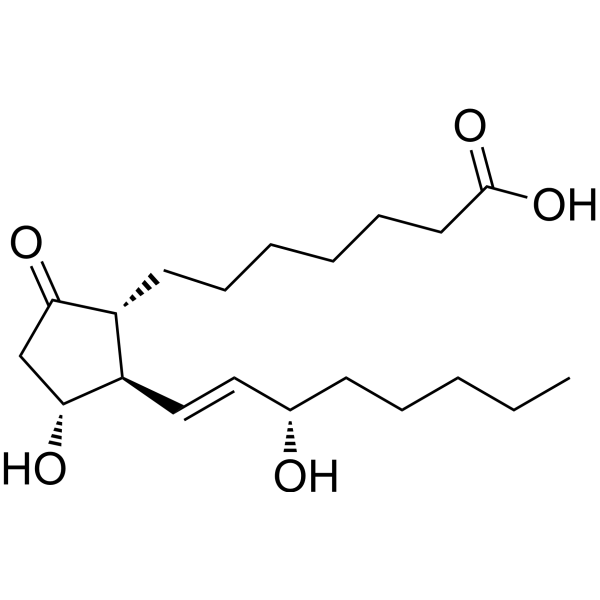
-
- HY-18971
-
TG4-155
1 Publications Verification
|
|
|
|
TG4-155 is a potent, brain-permeant and selective EP2 receptor antagonist with a Ki of 9.9 nM . TG4-155 shows low nanomolar antagonist activity against only EP2 and DP1 . TG4-155 has an EP2 Schild KB of 2.4 nM and displays 550-4750-fold selectivity for EP2 over EP1, EP3, EP4 and IP, but only 14-fold selectivity against the DP1 receptor .
|
-
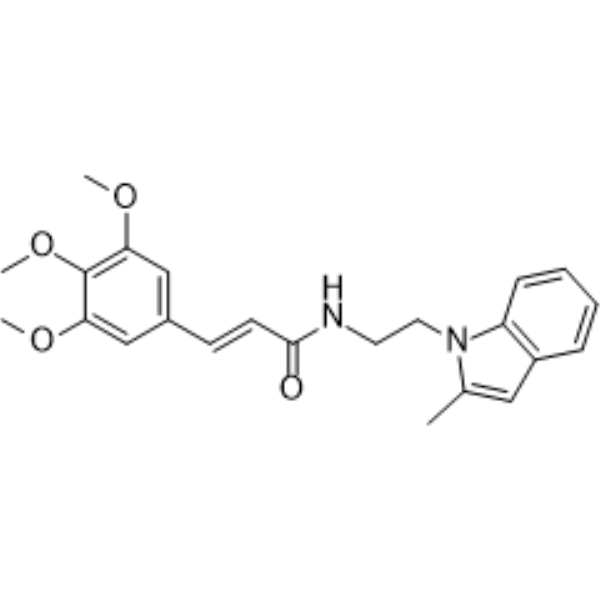
-
- HY-B0813
-
|
UT-15C
|
|
|
|
Treprostinil (UT-15C) diethanolamine is a potent EP2, DP1 and IP agonist with Ki values of 3.6, 4.4, 32.1, 212, 826, 2505 and 4680 nM for EP2, DP1, IP, EP1, EP4, EP3 and FP, respectively. Treprostinil (UT-15C) diethanolamine increases upregulation of cAMP toward maintaining homeostasis within the vasculature. Treprostinil (UT-15C) diethanolamine can result in vasodilatation of human pulmonary arteries [3].
|
-
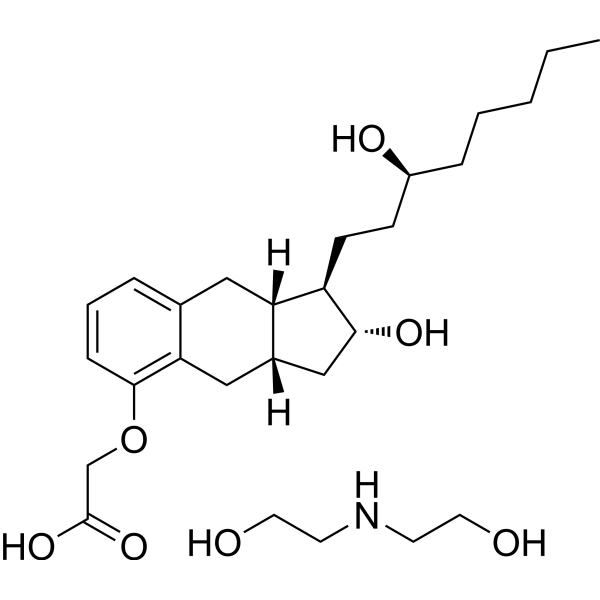
-
- HY-RS02304
-
|
|
Small Interfering RNA (siRNA)
|
Others
|
|
CDC42EP3 Human Pre-designed siRNA Set A contains three designed siRNAs for CDC42EP3 gene (Human), as well as a negative control, a positive control, and a FAM-labeled negative control.
|
-
CDC42EP3 Human Pre-designed siRNA Set A
CDC42EP3 Human Pre-designed siRNA Set A
-
- HY-B0584
-
|
Fluprostenol isopropyl ester; AL6221; Flu-Ipr
|
Prostaglandin Receptor
|
Endocrinology
|
|
Travoprost (Fluprostenol isopropyl ester), an isopropyl ester proagent, is a high affinity, selective FP prostaglandin full receptor agonist. Travoprost has the ocular hypotensive efficacy and has the potential for glaucoma and ocular hypertension .
|
-
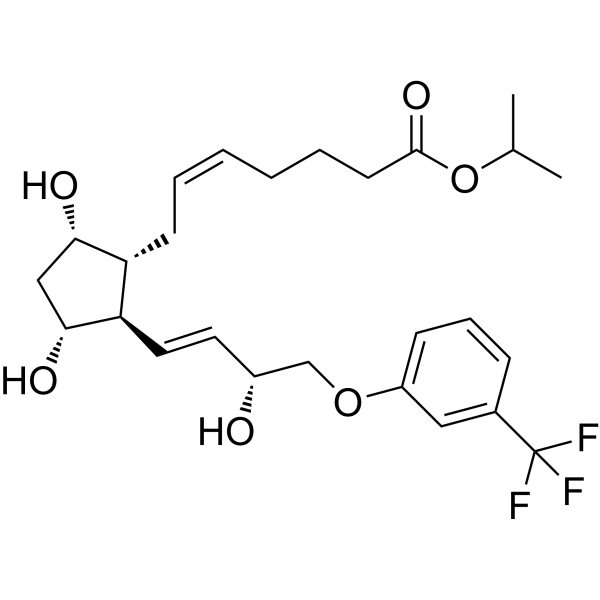
-
- HY-B0584A
-
|
5,6-trans-Fluprostenol isopropyl ester; 5,6-trans-AL6221; 5,6-trans-Flu-Ipr
|
Others
|
Endocrinology
|
|
5,6-trans-Travoprost is the isomer of Travoprost (HY-B0584), and can be used as an experimental control. Travoprost (Fluprostenol isopropyl ester), an isopropyl ester proagent, is a high affinity, selective FP prostaglandin full receptor agonist. Travoprost has the ocular hypotensive efficacy and has the potential for glaucoma and ocular hypertension .
|
-
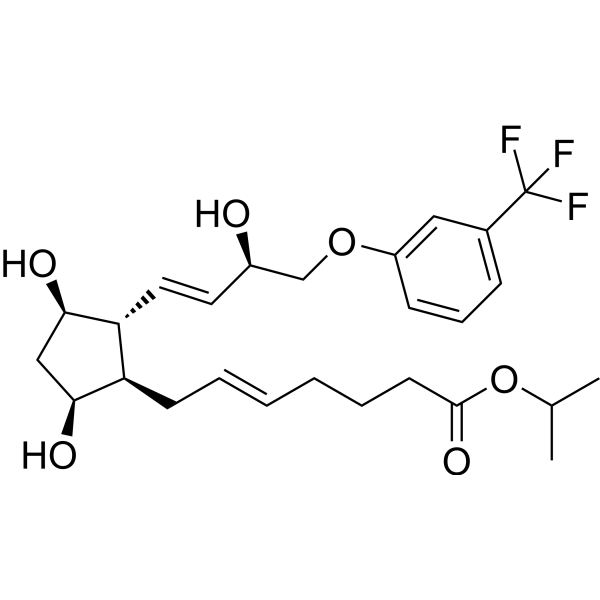
| Cat. No. |
Product Name |
Target |
Research Area |
-
- HY-P5702
-
|
|
Bacterial
Apoptosis
Fungal
|
Infection
|
|
EP3 is an antimicrobial peptide. EP3 has antibacterial and antifungal activities. EP3 inhibits E. gallinarum, P. pyocyanea, A. baumanii, K. terrigena with a MIC value of 12.85 μg/mL. EP3 also shows antitumor activity against cancer cells, and induces cell apoptosis .
|
| Cat. No. |
Product Name |
Category |
Target |
Chemical Structure |
-
- HY-B0131
-
|
Alprostadil; PGE1
|
Cardiovascular Disease
Structural Classification
Classification of Application Fields
Ketones, Aldehydes, Acids
Source classification
Endogenous metabolite
Disease Research Fields
|
Prostaglandin Receptor
Endogenous Metabolite
|
|
Prostaglandin E1 (Alprostadil) is a prostanoid receptor ligand, with Kis of 1.1 nM, 2.1 nM, 10 nM, 33 nM and 36 nM for mouse EP3, EP4, EP2, IP and EP1, respectively. Prostaglandin E1 induces vasodilation and inhibits platelet aggregation. Prostaglandin E1 can be used as a vasodilator for the research of peripheral vascular diseases [3].
|
-

-
- HY-P5702
-
-

-
- HY-B0131R
-
|
Alprostadil(Standard); PGE1 (Standard)
|
Cardiovascular Disease
Structural Classification
Classification of Application Fields
Ketones, Aldehydes, Acids
Source classification
Endogenous metabolite
Disease Research Fields
|
Prostaglandin Receptor
Endogenous Metabolite
|
|
Prostaglandin E1 (Standard) is the analytical standard of Prostaglandin E1. This product is intended for research and analytical applications. Prostaglandin E1 (Alprostadil) is a prostanoid receptor ligand, with Kis of 1.1 nM, 2.1 nM, 10 nM, 33 nM and 36 nM for mouse EP3, EP4, EP2, IP and EP1, respectively. Prostaglandin E1 induces vasodilation and inhibits platelet aggregation. Prostaglandin E1 can be used as a vasodilator for the research of peripheral vascular diseases [3].
|
-

| Cat. No. |
Product Name |
Chemical Structure |
-
- HY-B0131S2
-
|
|
|
Prostaglandin E1-d9 is deuterium labeled Prostaglandin E1.Prostaglandin E1 is a prostanoid receptor ligand, with Kis of 1.1 nM, 2.1 nM, 10 nM, 33 nM and 36 nM for mouse EP3, EP4, EP2, IP and EP1, respectively. Prostaglandin E1 induces vasodilation and inh
|
-

-
- HY-B0131S
-
|
|
|
Prostaglandin E1-d4 is the deuterium labeled Prostaglandin E1. Prostaglandin E1 (Alprostadil) is a prostanoid receptor ligand, with Kis of 1.1 nM, 2.1 nM, 10 nM, 33 nM and 36 nM for mouse EP3, EP4, EP2, IP and EP1, respectively. Prostaglandin E1 induces vasodilation and inhibits platelet aggregation. Prostaglandin E1 can be used as a vasodilator for the research of peripheral vascular diseases[1][2][3].
|
-

Your information is safe with us. * Required Fields.
Inquiry Information
- Product Name:
- Cat. No.:
- Quantity:
- MCE Japan Authorized Agent:












































